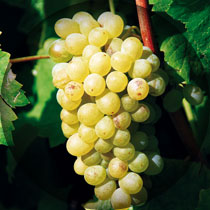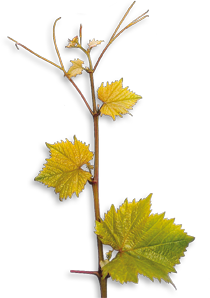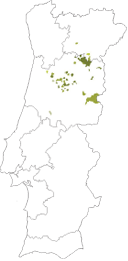Verdelho (PT)
Variety: white | Category III | Portugal


General Information
Verdelho


Origin: Portuguese archipelagos in the Atlantic. It is possible that this variety was brought to Madeira by Dom Afonso V in the 15th century, together with the Malvasia and other Greek varieties, from the Mediterranean island of Candia in Crete.
Chief areas of distribution: This variety is hardly grown on the Portuguese mainland. It is found in very limited areas of the Azores, Madeira, and probably the Canary islands, but has been widely distrubuted in the new world of wine. Australia has 1,603 ha, whilst oenologists recommend it in South Africa and Argentina. In Régua's ampelographic collection, Truel (1984) refers to the Verdelho on the Douro River, using the synonym Gouveio, astonishingly, with photographs typical of the variety, and an aberrant description of the Verdelho from the Dão region. This misunderstanding merely serves to highlight the extent of the enigma surrounding this magnificent and internationally-renowned Portuguese variety. A significant upswing in the cultivation of the Verdelho on the Portuguese mainland is expected in the near future, since it has now been authorised in those areas where its historic synonyms were first planted.
Official synonym(s) (national and OIV): None.
Historic and regional synonyms: Unknown.
Homonym(s): Other varieties are the Verdelho Roxo (Nº 331), Verdelho-Tinto (Nº 332), Verdello (ES), Verdejo (ES), and Verdello (IT). The historical Verdelho of the Portuguese mainland Verdelhos was the Gouveio (Nº 142) (cf. Ruy Fernandes, 1531; Lacerda Lobo, 1790; Teixeira Gyrão, 1822; Vila Maior, 1875), but this homonymity was clarified in 2000.
Area under cultivation: Hardly any cultivation on the mainland. On the islands, 20 ha are planted to this variety.
New plantings: Almost no plantings on the mainland, because virus-free propagating material does not yet exist.
Trend: Probably upward in future.
Varietal variability: Not yet researched.
Availability of propagating material: Hardly available at all.
Molecular Profile (OIV)
Regional Classification
Morphology
Phenology
Vegetative Potential
Viticultural Parameters
Oenology
Variety Characteristics
| VVMD5 | VVMD7 | VVMD27 | VrZag62 | VrZag79 | VVs2 | ||||||
| Allele1 | Allele2 | Allele1 | Allele2 | Allele1 | Allele2 | Allele1 | Allele2 | Allele1 | Allele2 | Allele1 | Allele2 |
| 222 | 232 | 235 | 253 | 181 | 189 | 194 | 196 | 247 | 251 | 135 | 153 |
DOC quality wine: Dão, Ribatejo, Madeira.
IPR quality wine: Pico, Tocoito, Graciosa.
Regional wine: Douro, Porto, Beiras, Ribatejana, Alentejano, Azores.
Young shoot (form of tip): Open, red tip, and medium anthocyanin colouration, sparse hairs.
Young leaf: Green, with medium anthocyanin colouration. Hairs of medium density.
Young shoot: Nodes and internodes with red stripes on dorsal and ventral sides, medium anthocyanin colouration. Tendrils of medium length.
Inflorescence (sex of flower): Hermaphrodite.
Mature leaf: Medium size, pentagonal, five lobes, medium green, regular profile, slightly undulate and rugose. Medium convex teeth. V-shaped slightly overlapping petiolar sinus. Anthocyanin colouration of the main vein in the area of the petiole. Open V-shaped upper lateral sinuses, medium density prostrate hairs on lower side of blade.
Bunch: Medium to small. Dense.
Berry: Medium.
Time of bud burst: Normal, 6 days after the Fernão Pires.
Flowering: Normal, 4 days after the Fernão Pires.
Berry (colour change): Early, 2 days before the Fernão Pires.
Berry (harvest ripe): Early, two weeks before the Fernão Pires.
Vigour of shoot growth: Medium.
Pruning weight:: 2,000 – 3,000 kg/ha.
Shoot attitude (habit): Semi-erect, some plagiotropic.
Length of internodes: Seemingly irregular.
Shoot length: Medium, some very long.
Tendency to form lateral shoots: Low.
Rate of multiple bud bursts: Low.
Bud fertility index: Medium to high.
Yield: Low with traditional material; medium with virus-free clonal material (8 - 15 t/ha).
Yield consistency: Consistent.
Crop uniformity: Uniform.
Sensitivity to abiotic factors: Robust variety, low susceptibility to excessive humidity.
Susceptibility to fungal diseases: Low susceptibility to Peronospora and Oidium, medium susceptibility to Botrytis.
Systemic viral infection prior to selection: To date, it has not been possible to find a virus-free clone of this variety in its region of origin in Portugal.
Bunch size: Small-medium (132 g).
Bunch density: Dense.
Berry skin: Thick.
Seeds per berry: 1.3.
Vineyard conduction system: Any type, easily trainable.
Soil requirement: Deep soils, medium humidity.
Climatic requirements: Flexible; adapts to coastal climates and to the mainland interior.
Vine density: Normal.
Rootstock: No experience in continental Portugal.
Irrigation: Recommended in places where drought stress occurs.
Incidence of coulure/millerandage: Somewhat susceptible.
Spoilage of mature berries: Medium to minimal.
Risk of bird damage: Protection recommended.
Machine harvest suitability: No experience, although possible in theory at lower temperatures.
Wine type: Table wine, dessert wine, sparkling wine.
Potential alcohol content: High (14% vol.).
Natural acidity of must: Good (5 g/l).
Total anthocyanins: No experience in continental Portugal.
Risk of oxidation of wine: Low.
Aromatic profile: Not yet analysed.
Ageing Potential: Excellent.
Blending recommendation: Little experience in continental Portugal; blended with Sercial on the islands.
Wine Descriptors: Citrine in colour, with an aroma evocative of exotic fruits, it is well-structured and well-balanced. Sustained mouth, and good accents when mature. Suitable as a smooth table or dessert wine but also as a dry table wine.
Wine quality: High quality variety.
Variety Characteristics: Historically, this variety has an excellent reputation, as practical experience in Portugal shows. Fresh and aromatic wines, highly suited to hot, dry regions. It is hoped that this variety will produce improved wines from vineyards in the mainland interior.

